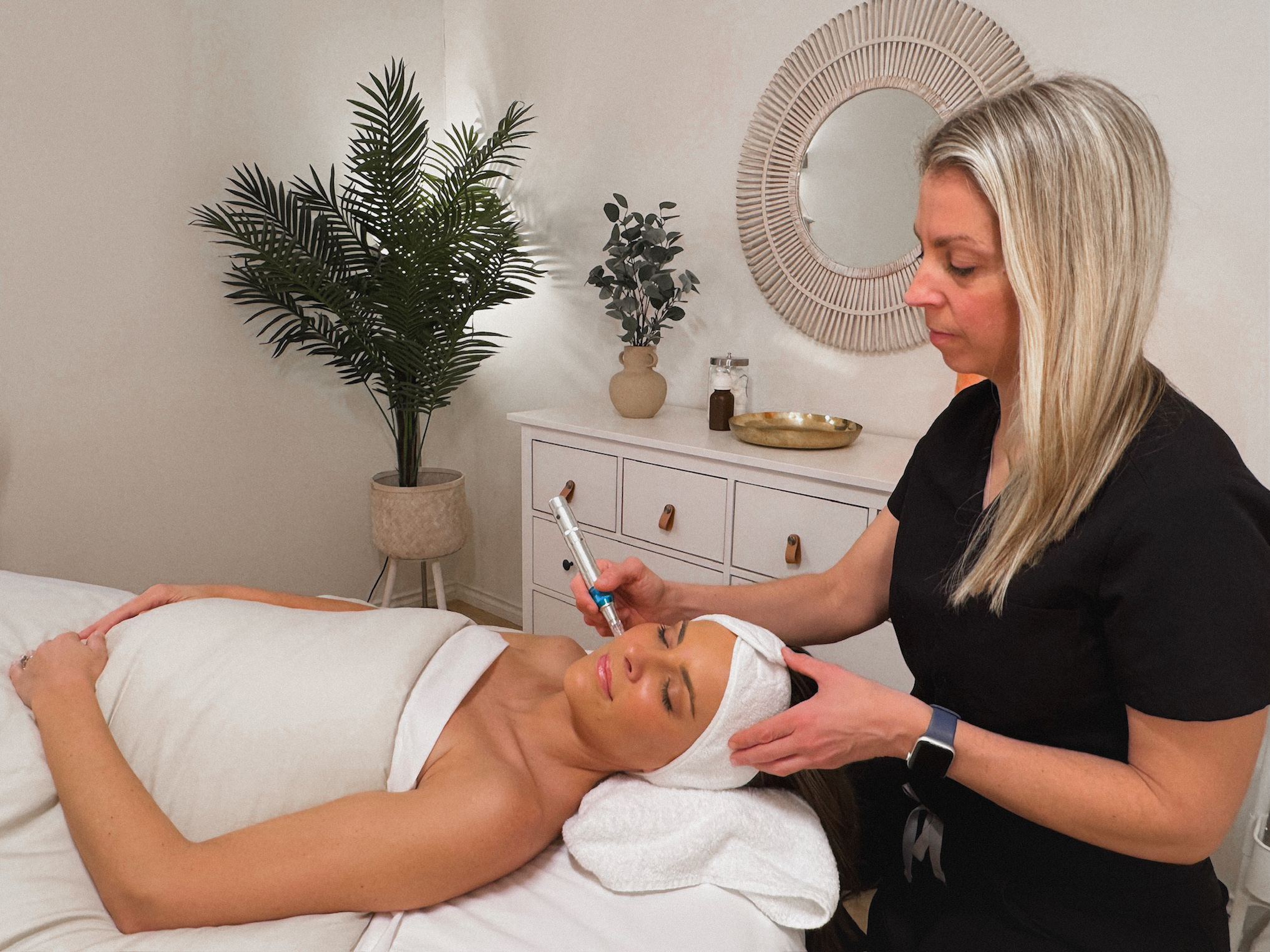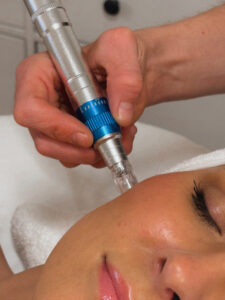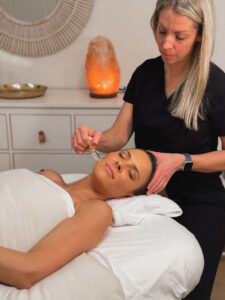Microneedling has surged in popularity as a minimally invasive cosmetic treatment known for rejuvenating skin, reducing the appearance of scars, smoothing wrinkles, and improving overall skin texture. As with any skincare procedure, questions and concerns naturally arise—one of the most common being: Can microneedling cause scarring?
This is an important and valid question, especially for those who are considering the treatment for the first time or have sensitive or acne-prone skin. In this blog post, we’ll explore the science behind microneedling, what causes scarring, and most importantly, how microneedling—when done correctly—actually reduces the appearance of scars rather than causing them.
Let’s dive into the facts so you can make an informed decision about your skin health.

What Is Microneedling?
Microneedling, also known as Collagen Induction Therapy (CIT), is a skin rejuvenation treatment that involves the use of a device equipped with tiny, sterile needles to create micro-injuries on the surface of the skin. These controlled micro-injuries stimulate the body’s natural healing response, encouraging the production of collagen and elastin—two key proteins responsible for firm, youthful, and healthy skin.
Microneedling can address a variety of skin concerns, including:
Acne scars
Fine lines and wrinkles
Stretch marks
Enlarged pores
Uneven skin tone or texture
Hyperpigmentation
The procedure can be performed on the face, neck, décolleté, and other parts of the body, depending on the individual’s needs and goals. Other areas my clients love to see results is their hands, ears, c-section scars and stretch marks.
Can Microneedling Cause Scarring?
The Short Answer: Not When Performed Correctly
When performed by a qualified and experienced practitioner, microneedling does not cause scarring. In fact, it is a gold-standard treatment for minimizing the appearance of scars, especially acne scars and surgical scars. However, like any skin procedure, microneedling carries a small risk of adverse effects if not performed correctly or if aftercare instructions are not followed.
So, let’s break this down further.

What Causes Scarring in General?
Scarring is the result of an overactive or dysfunctional healing process in the skin. When the dermis (the deeper layer of the skin) is injured, the body produces collagen to repair the damage. If too much collagen is produced, it can result in raised scars (hypertrophic or keloid scars). On the other hand, if too little collagen is produced, it can result in atrophic scars, such as those left behind by severe acne.
Several factors can increase your risk of scarring, including:
Improper technique or using the wrong needle depth
Infections due to non-sterile equipment
Inadequate skin preparation or poor hygiene
Aggressive microneedling performed too frequently
Pre-existing medical conditions that impair healing
Picking, scratching, or irritating the skin during healing
Why Professional Microneedling Is Safe
Choosing a certified, medically trained provider, like a Registered Acupuncturist, makes all the difference when it comes to safety and results. Here’s why:
1. Proper Technique
Registered professionals, like myself, are trained to evaluate your skin type and condition, and select the appropriate needle depth and device settings for a safe and effective treatment. In untrained hands, incorrect needle penetration can damage the skin and potentially lead to scarring.
2. Sterile Tools and Clinical Setting
Professional-grade microneedling devices are used in a clean, controlled environment with sterile, single-use cartridges. This dramatically reduces the risk of infection—a leading contributor to scarring.
3. Personalized Treatment Plans
Every skin is different. A professional will tailor your microneedling session to your unique skin needs, which ensures a safer, more targeted approach without compromising the skin’s integrity.
4. Post-Treatment Care Guidance
Proper aftercare is crucial. A certified expert will provide you with specific instructions to optimize healing and minimize the risk of irritation, inflammation, or infection.
What About At-Home Microneedling Devices?
At-home microneedling tools, like derma rollers, have grown in popularity—but they come with significant risks. The needles on these devices are usually duller and less precise, and users may not understand the right pressure, angle, or hygiene protocols. This increases the chance of:
Skin tearing rather than controlled micro-injuries
Bacterial contamination
Improper healing, which may lead to scarring
For this reason, at home microneedling should be consulted with a licensed professionals who are trained in both safety and effectiveness. Microneedling at home can be a very effective addition to your routine when done properly. This is why I offer consultations and professional grade kits for my clients to use at home.
What Does the Healing Process Look Like?
After a professional microneedling session, the skin may appear red and feel slightly tender—similar to a mild sunburn. This is completely normal and typically subsides within 24–72 hours. Some people may experience minor peeling or flaking as the skin regenerates, which is also a sign that healing and renewal are underway.
With proper care, this process supports smooth, scar-free skin. The risk of scarring is extremely low when aftercare guidelines are followed, which may include:
Avoiding sun exposure
Not touching or picking at the skin
Keeping the skin clean and moisturized
Using only recommended products
Avoiding makeup or active skincare ingredients for a few days
Microneedling for Scar Reduction
Ironically, one of microneedling’s most celebrated benefits is its ability to reduce existing scars. It is particularly effective for:
Acne Scars – Microneedling breaks down fibrous tissue and encourages collagen to fill in atrophic scars, making them less noticeable over time.
Surgical Scars – With a series of treatments, surgical scars can become smoother and lighter in color.
Stretch Marks – Microneedling stimulates collagen in areas with stretch marks, helping to fade them and improve skin texture.
Studies show that microneedling can improve the appearance of scars by up to 70–80% over a course of treatments, depending on the type and depth of the scar.

When to Avoid Microneedling
There are a few situations where microneedling might not be appropriate or should be delayed:
Active acne or skin infections
Open wounds or rashes
Keloid scar history (must be assessed by a practitioner)
Uncontrolled rosacea or eczema
Certain medications that impair healing (like Accutane)
This is why consultation with a certified professional is essential—so your skin can be thoroughly evaluated and your treatment customized for safety and success.
Real Results: What Clients Are Saying
Clients who’ve worked with Katie Musicco, Registered Acupuncturist and Certified Microneedling Expert, often report not only smoother skin but also increased confidence. With her integrative approach—blending Traditional Chinese Medicine principles with modern skin science—Katie ensures each treatment is both therapeutic and results-driven.
Final Verdict: Microneedling and Scarring
So, can microneedling cause scarring?
Yes—but only if it’s done improperly.
No—if it’s done by a trained professional using the right technique, tools, and aftercare.
In the hands of an expert like Katie Musicco, microneedling is a safe, effective, and minimally invasive treatment that promotes healing—not harm. With a tailored treatment plan and holistic support, you can address scars, fine lines, and skin concerns without fear of making things worse.
Ready to Reclaim Your Skin Confidence?
If you’re ready to transform your skin and experience the healing power of professional microneedling, Katie Musicco is here to help. With her background in acupuncture and holistic wellness, every session is designed to support not only your skin, but your overall vitality.
✨ Book your personalized microneedling treatment with Katie today and take the first step toward radiant, scar-free skin.
📞 Call (250) 655-1660 or book online to schedule your session.
Article By: Katie Musicco

I'm Katie Musicco
A Registered Acupuncturist and Cosmetic Acupuncture Expert and my obsession is teaching others how to look and feel younger naturally. I’m here to help you do just that!
Let's hang out
let's be
Pen Pals
Dropping in with weekly health hacks, and content created with Y-O-U in mind, because no one likes getting junk mail, am I right?



